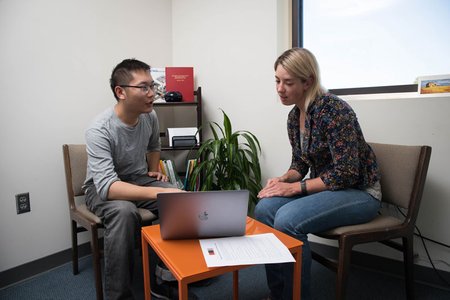Writing Center Expands Tutoring to Include Assistance with STEM Assignments
All scientists and engineers, whether they study chemistry, computer science, physics, or electrical or mechanical engineering, need to know how to write, not just for everyday communication but also so they can prepare research proposals, theses, and research papers for publication in peer-reviewed journals.
But for many students in scientific fields, the development of writing skills often takes a back seat to the mastering of laboratory techniques and how to conduct research.
Caltech's Hixon Writing Center is aiming to change that. The center, established in 2000 with a gift from Pasadena philanthropists Alexander P. and Adelaide F. Hixon and part of the Division of the Humanities and Social Sciences (HSS), has long offered tutoring for Caltech writers, but the majority of that work focused on papers for HSS courses. Now, thanks to an additional contribution from Adelaide. F. Hixon in 2016 as part of Break Through: The Caltech Campaign, it is also able to offer assistance to Caltech undergraduates with scientific and engineering writing.
"Because many of our students are focused on STEM [science, technology, engineering, and math] fields, Caltech and the Hixon Writing Center should help them become effective STEM writers," says Jean-Laurent Rosenthal (PhD '88), HSS chair, the Rea A. and Lela G. Axline Professor of Business Economics and Ronald and Maxine Linde Leadership Chair.
Last fall, the center hired its first STEM writing specialist, and by the end of the academic year, nearly 40 percent of the students visiting the center were seeking help with scientific or technical writing.
"The goal was to create a high-quality one-on-one tutoring resource for our students when they're writing technical or scientific papers," says Hixon director Susanne Hall. "So, now a physicist, a biologist—a student in any scientific discipline—can come into the writing center and get help on their academic writing from a tutor with firsthand experience of the styles and genres of scientific communication."
In hiring professional tutors for STEM writing, Hall looked for individuals with strong scientific research backgrounds. For example, STEM writing specialist Christina Birch has a PhD in biological engineering from MIT. STEM writing specialist Erin Burkett has a PhD in geophysics from UC Davis.
"Students, I think, listen a little more intently when they have a fellow engineer standing in front of them saying, 'Writing is important. Let me give you some tricks and tips,'" Birch says.
The center has also begun a partnership with the Division of Engineering and Applied Science (EAS) to bring STEM writing instruction directly into classrooms, by working with faculty in the division who already assign writing in their classes. The STEM writing specialists also serve as lecturers for an EAS class called Written Technical Communication in Engineering and Applied Science (E 11).
"Effective writing is best learned in the student's field," says Rosenthal. "Rethinking E 11 started with a conversation between EAS faculty and Hixon staff to determine how best to serve our budding engineers."
Birch says it can be difficult sometimes to get engineering students interested in writing but adds that they become receptive when they see writing that's clearly relevant to their fields.
"I brought in lots of discipline-specific examples. We read and analyzed a paper that was published by a network scientist at Facebook, and I think the students really got into it."
Adam Wierman, a professor of computing and mathematical sciences, has been especially interested in support for STEM writers and has worked with Birch to hold writing workshops for his students.
"Communication is of fundamental importance for students today, but it's hard to learn in isolation," he says. "Being able to partner with Hixon to embed writing and communication into my course allowed us to teach students at the moment they needed it. Christina had students eating out of her hands," he adds. "I have never seen students so excited about learning communication skills."
 STEM writing specialist Christina Birch (right) during a tutoring session with a student in the Hixon Writing Center.
Credit: Caltech
STEM writing specialist Christina Birch (right) during a tutoring session with a student in the Hixon Writing Center.
Credit: Caltech

